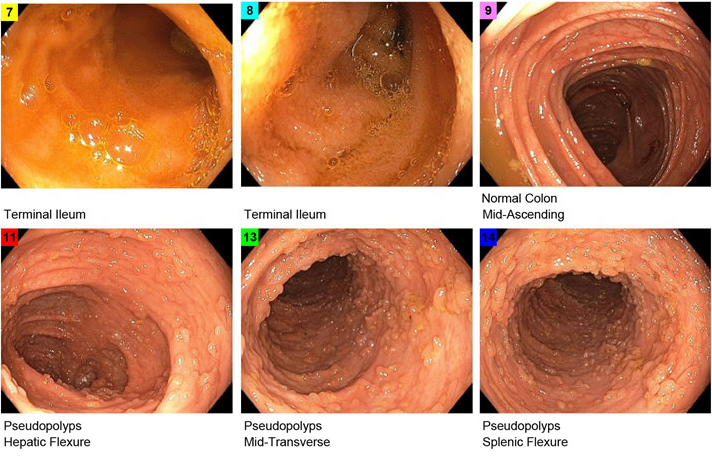Tuesday Poster Session
Category: Colon
P4649 - Beyond the Usual Suspects: Unmasking Steroid-Refractory Eosinophilic Colitis in a Challenging Clinical Context

Leeann Hu, MD
Naval Medical Center Portsmouth
Suffolk, VA
Presenting Author(s)
1Naval Medical Center Portsmouth, Elk River, MN; 2Fort Eustis McDonald Army Health Center, Fort Eustis, VA; 3Uniformed Services University of the Health Sciences, Portsmouth, VA; 4Naval Medical Center Portsmouth, Suffolk, VA; 5McDonald Army Health Clinic, Fort Eustis, VA; 6Naval Medical Center Portsmouth, Portsmouth, VA
Introduction:
Eosinophilic colitis (EoC) is a rare subtype of eosinophilic gastrointestinal diseases characterized by gastrointestinal (GI) symptoms and histologically by increased eosinophilic infiltration of the colonic mucosa in the absence of secondary causes of eosinophilia. EoC is a poorly understood disease, and diagnostic thresholds and treatments have not been standardized. We present an uncommon case of idiopathic EoC with a partial response to oral steroids.
Case Description/
Methods:
A 43-year-old male with a history of hiatal hernia status post Nissen fundoplication presented with abdominal pain and constipation. A colonoscopy two years prior for rectal bleeding notable for diverticular-associated colitis, otherwise unremarkable, and he was diagnosed with irritable bowel syndrome with constipation (IBS-C).
However, management for presumed IBS-C was unsuccessful with worsening abdominal pain, diarrhea, poor oral intake, and hematochezia. CT imaging revealed new colonic wall thickening from the distal ascending colon to the rectosigmoid wall. Colonoscopy demonstrated severe segmental inflammation with friability and ulceration from the hepatic flexure to the distal descending colon. Biopsies showed non-specific focal active colitis. Fecal calprotectin was normal. Evaluation was unremarkable for infectious, thyroid, and allergy etiologies. Three months later, due to persistent symptoms, a repeat colonoscopy revealed numerous pseudopolyps and biopsies demonstrated up to 50 eosinophils/hpf infiltration without other inflammatory changes. Given that secondary causes were ruled out, the patient was diagnosed with EoC. The patient’s symptoms improved with prednisone but only partially responded to a transition to budesonide.
Discussion:
In infants, primary EoC is often associated with food allergies. However, in adults, it is a poorly understood disorder that is still studied from case reports and small case series. Endoscopic findings often overlap with a spectrum of other gastrointestinal diseases and treatment is not standardized. Current understanding recommends initial therapy with systemic corticosteroids but recognizes that response is variable and adult cases are often steroid-refractory, presenting a management challenge. This case highlights the diagnostic and therapeutic challenges of EoC and underscores the need for further research and consensus on diagnostic criteria and optimal management strategies for adult EoC.
Figure: Pseudopolyps observed during repeat colonoscopy that revealed eosinophilic colitis on biopsy.
Disclosures:
Christopher Thorndal indicated no relevant financial relationships.
Benjamin Ingerson indicated no relevant financial relationships.
Allison Bush indicated no relevant financial relationships.
Leeann Hu indicated no relevant financial relationships.
Quentin Ray indicated no relevant financial relationships.
Bruno Schmitz indicated no relevant financial relationships.
Christopher Thorndal, DO1, Benjamin Ingerson, PA-C2, Allison Bush, MD3, Leeann Hu, MD4, Quentin Ray, 5, Bruno Schmitz, MD6. P4649 - Beyond the Usual Suspects: Unmasking Steroid-Refractory Eosinophilic Colitis in a Challenging Clinical Context, ACG 2025 Annual Scientific Meeting Abstracts. Phoenix, AZ: American College of Gastroenterology.

